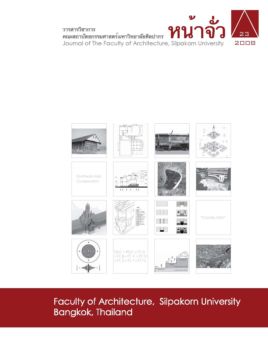การออกแบบและประยุกต์ผนังวัสดุแผ่นประกับโฟมเพื่อใช้ก่อสร้างอาคารพักอาศัย
Keywords:
ผนังวัสดุ, แผ่นประกบโฟม, ผนังเบา, ผนังสำเร็จรูป, Sandwich Panel, Housing System, Light Panel Construction, Energy Efficient BuildingAbstract
ผลิตภัณฑ์ผนังวัสดุแผ่นประกบโฟมในท้องตลาด ควรได้รับการออกแบบ หรือปรับปรุงรูปแบบให้เหมาะสมกับประเภทอาคาร และสภาพอากาศในประเทศไทย จำเป็นที่สถาปนิกผู้ออกแบบอาคารและผลิตภัณฑ์ (Product architect) จะต้องศึกษาเลือก และประยุกต์ใช้แผ่นผนังสำเร็จรูป รอยต่อ และระบบการก่อสร้างอย่างรอบคอบ เพื่อให้ได้อาคารที่มีสมรรถนะการใช้งานที่สูงขึ้น และประหยัดค่าก่อสร้าง บทความนี้นำเสนอรูปแบบระบบรอยต่อ และแนวทางการประยุกต์ใช้ผนังวัสดุแผ่นประกบโฟมสำหรับอาคารพักอาศัยในประเทศไทย ซึ่งสรุปได้จากโครงการวิจัยที่เคยออกแบบไว้ และให้ความคิดเห็นเพิ่มเติมเพื่อการพัฒนาต่อไป
เนื่องจากชิ้นส่วนอาคารสำเร็จรูป การผลิตในระบบอุตสาหกรรม และระบบการก่อสร้างที่มีน้ำหนักเบาได้มีบทบาทสำคัญต่ออุตสาหกรรมก่อสร้างในประเทศไทยเพิ่มขึ้นเรื่อยๆ ผู้ออกแบบผลิตภัณฑ์ สถาปนิก และนักวิชาการควรให้ความสนใจและเข้ามามีส่วนร่วมในการวิจัย ออกแบบ และพัฒนา (RD&D) กันมากขึ้น เพื่อให้ได้ชิ้นส่วนประกอบอาคารที่นำไปใช้งานได้จริงและมีประสิทธิภาพสูงขึ้น มิฉะนั้นแล้ว สมรรถนะของอาคารที่ดี และความสวยงามของงานสถาปัตยกรรมร่วมสมัยในประเทศไทย ก็ยากที่จะค้นพบหรือพัฒนาได้ต่อไปเช่นกัน
The Applications of Structural Insulated Panels for Housing Construction in Thailand
Charunpat Puvanant
Associate Professor, Faculty of Architecture, Silpakorn University
Structural insulated panel products in Thailand should be designed or adapted to suit building types of construction and the climate. The panel types, jointing and construction systems need to be carefully studied, selected and applied by design and product architects to get higher-performance buildings with more economical construction. This paper presents a few designs of the structural insulated panels from previous studies, joint details and their possible applications for housing construction in Thailand with some remarks for further development. Since prefabricated building components, industrialized production, and lightweight construction systems are significantly taking more roles in Thai construction industry, more attention and involvement of designers, product architects and academics in RD&D (research, design and development) are needed to get more practical building components and efficient systems. Otherwise higher-building performance and aesthetic in Thai contemporary architecture are hardly to be reached or developed.





